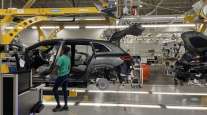Staff Reporter
Simulators Hold Potential for CDL Training, Testing, Experts Say

[Stay on top of transportation news: Get TTNews in your inbox.]
Simulators can serve as a resource for truck driver training and testing, especially during the coronavirus pandemic, according to experts assembled for a webinar hosted by the Transportation Research Board on Nov. 6.
Social distancing protocols established in response to COVID-19 present challenges for commercial driver license training and testing. Traditional driving tests are conducted by professionals who sit beside the driver in the cab of a truck, which does not offer enough space for appropriate social distance.
Pierro Hirsch, director of road safety research at Virage Simulation Inc., said simulators offer a safe solution. Virage designs and manufactures simulator equipment and offers services that support research and the driving school industry.
Hirsch, whose early exposure to driving simulators began at his father’s driving school, said the devices have developed over the years and now employ motion-based, 180-degree screens.
“Simulation is a proven solution as an effective training tool,” Hirsch said. “With simulators, we have an untapped source of a new method for improving driver training and testing. We think there are applications even after COVID.”
TRB Slides by Transport Topics on Scribd
The pandemic also has placed some restrictions on CDL credentialing operations at the state government level. Some states are offering limited services, and some are scheduling service by appointment only. Hirsch indicated that, on average, states are issuing credentials at a 60-70% capacity as of September.
John Rojas, director of transportation training services at Del Mar College, said that a person who called to book a skills test in Texas during the first week of November would be scheduled to come in for the exam in February. Del Mar College is a community college in Corpus Christi.
Certain elements of simulators, such as the ease with which they can be cleaned, have been valuable during the pandemic, Rojas said.
Simulated environments such as railroad crossings and snowy mountain passes are especially useful for schools in places that do not have those physical features nearby, Rojas said. He noted the mountainous terrain simulation is useful for his school because there are not a lot of mountains in Corpus Christi. Simulators also can offer an opportunity to test tasks such as backing into a loading dock or parallel parking, both of which require a lot of space that schools may not have access to.
Additionally, Rojas said simulators are useful for testing hazard perception, such as deer darting across the road or cars pulling out of driveways.
“You can create an equal playing ground,” Rojas said. “All the tests can be exactly the same.”
Hirsch noted that other fields, such as aviation, military and medicine, have embraced simulators as training tools.
Hirsch said simulators are capable of psychological fidelity, which can make participants feel that they are responding to a real event. He used the example of experienced truck drivers who were sweating after participating in a simulation that tested their use of ramps in the event of brake failure.
“First reactions that people have shared with me is ‘It’s not like the real thing,’ ” Hirsch said. “Dozens of studies have demonstrated that drivers’ performance on truck or car simulators very closely matches what they do in the real vehicle in the real world. It’s remarkable how effective it is and how naturalistically people behave even though they know they’re in a simulator. If they realize that it could happen to them, they’ll be very serious about how they respond in the simulator.”
Want more news? Listen to today's daily briefing:
Subscribe: Apple Podcasts | Spotify | Amazon Alexa | Google Assistant | More


